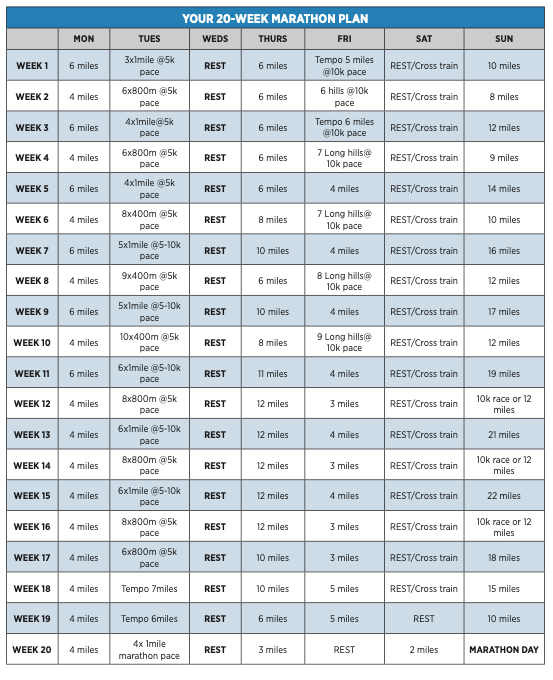Trying to squeeze your marathon training into 12 or even 16 weeks can be difficult – there’s less time for more to go wrong. Why not try a 20-week marathon plan instead? Start now to hit peak fitness for that next marathon
Many people start marathon training 12 weeks before the race, but increasing this to 20 weeks could see you improve your race performance. Winter is a time when illness and injury are rife and training can take a serious hit. Extending marathon training by an extra eight weeks ensures that you have enough time to build up mileage gradually, while also carrying out some decent speed work.
The training plan detailed below will take you through a build and recovery cycle. Some weeks will include higher mileage, other weeks will include tougher speed work. Rest and recovery is included throughout and is a vital part of the training. The plan ensures you move progressively to a point where you are ready to run your best marathon, while preventing overtraining.
The aim of the plan is to speed up your marathon times, but if you are new to marathon training don’t be put off. This 20-week marathon plan will give you plenty of time to add miles gradually. As long as you are already running at least three days a week, you can follow this plan and slowly build up to 26.2 miles.
Consistency is key
Marathon training is a major commitment and cannot be taken lightly. A marathon is a long way to run and therefore training requires dedication and consistency. Taking time to move through phases of building, followed by recovery is key to ensuring the body can cope with three or more hours of running. Build too quickly and recover too little and you risk injury. Build too little and you risk hitting the start line unprepared.
No single session will help you run the race faster or better. Consistent training in a controlled and well thought out way is the key to improving marathon times. This means that, if you miss a session you are not sabotaging your race.
You should, however, aim to get as close to the plan as possible to ensure success. Be consistent and plan your week. If you know you have several engagements in the week that will take you off plan, try at least to run at the weekend and carry out some quality sessions.
Most marathon runners try to do their long run on a Sunday, away from distraction, with plenty of time to complete the miles. As you get closer to marathon day the weekly long runs will get close to the marathon distance, so plan ahead by organising events either earlier in the plan or, better still, after the marathon.
The 20-week marathon plan switches between speed weeks and high mileage weeks. Speed work and high mileage are two very different methods for improving marathon times. By combining these approaches, you get the best of both worlds, a strong, fit body from speed and one that can adapt to the demands of long distance.

How to follow the 20-week marathon plan
The section below sets out the different sessions included in the training plan. Each session type has a purpose, whether it be increasing leg speed or enhancing cardio vascular strength. Carried out in a systematic way, throughout the training period, these sessions will help you develop greater fitness and faster times.
Long runs
Long runs are the foundation of all marathon training programmes. They are crucial for preparing the body for the demands of the marathon distance.
Gradually increasing the long run week by week will both enhance the glycogen-storing capacity of the liver and help muscles, ligaments and tendons to withstand mile after mile of pounding. They are also important in developing confidence in your ability to go the distance.
Try not to split these sessions – they are most effective when carried out as a single run, so that glycogen depletion occurs. Glycogen is carbohydrate stored in the body and along with fat, is an essential fuel for long distance running.
Another advantage of the long run is practising race day nutrition. Try out some different pre and post-run meals and test out different gels to keep you going during the runs. Getting your nutrition right will be invaluable in avoiding race day stomach upsets!
Long runs should be at least 30 seconds per mile slower than race pace. To get the best out of these runs try starting off very easy for the first three miles, then build up to a strong finish at a slightly faster pace.
Tempo sessions and races
If you are aiming for a particular time in a marathon then tempo sessions and races are a must. Tempo sessions will get you running at, or faster than, marathon race pace. They most closely simulate the conditions you will encounter in the race itself and as such are an invaluable part of training.
The duration, frequency and intensity of a tempo run is important to get right. You should be running the distance specified in the plan at, or close to, race pace. As a result, this will not feel comfortable – you should feel like you’re working hard. Making time each week for these sessions will make you faster.
Throughout the plan, I have suggested races to take part in. Racing will help you get the psychological edge on your competitors come marathon race day as you will have experience of pacing. Racing teaches you to hold back at the start and maintain a good, sustainable speed.
Speed Sessions
Along with tempo runs, speed sessions will push you to become faster and stronger. During weeks with lower mileage your speed sessions will be more intense. Make sure you take one to two minutes recovery between each repetition during your speed work.
Try to stick to the plan with speed work. There is no doubt that these sessions are hard, but they are invaluable for strength and cardiovascular fitness. This is where you truly find out what your limits are, so make the most of it. Even better if you can find a friend or two to race against!
The best way to improve your race readiness is through speed sessions. If you do not run faster than race pace in speed training you will find it very difficult to run to your potential in the marathon.

Hill sessions
Running up hills is one of the best ways to increase strength. Throughout the first 10 weeks of training, hill sessions are included every two weeks. When performing these sessions make sure you warm up sufficiently by slow running for one to two miles.
Try to find hills that take at least two minutes to get up. Run up the hill at a good speed, you shouldn’t be flat out but you also shouldn’t being going too slowly, get on your toes and push yourself.
Once you’re at the top, take a breather and slowly jog/walk back to the start, ready for the next repetition. Aim to complete each hill rep in the same time to make sure you are putting in enough effort.
Cross training
One day a week is dedicated to rest/cross training. If you are feeling up to it and are not too tired, it’s a good idea to include some cross training. This can include cycling, swimming or light weight training. Try to do something you enjoy that takes your mind off running while still keeping you active.
Cycling has been shown to be a great way to build some muscle, thereby helping to prevent injury. Weight training in the form of lunges, squats, deadlifts and core work is very beneficial to runners, not only to maintain muscle but also to strengthen the body and prevent injury.

Recovery sessions
Recovery sessions are a very important part of the plan and as such, must be run at the right intensity. These runs will help clean out the body of lactic acid and rebuild the structure of the muscles after hard training.
Under no circumstances should recovery runs turn into fast runs. You should be running slower than your long runs, preferably on a flat surface. Enjoy these sessions, and make the most of going slow!
Taper weeks
The last two weeks are referred to as ‘taper weeks’. This is your opportunity to take your foot off the pedal, and completely scale back your running. Suddenly your 10 mile runs will become three miles. Many runners fall at this last hurdle, thinking that they should cram in extra miles. This is a huge mistake. Tapering is possibly the most important part of the plan.
You want to arrive at the start line, chomping at the bit, full of energy and with fresh legs. Tapering gives you all these things. During the last two weeks do not, under any circumstances, train more than the plan stipulates.
This is when your body will replenish glycogen stores, as you eat carbohydrates, ready for race day and mentally you will have a break from running. Make the most of it, buy a book, sleep in and try not to overthink race day.







